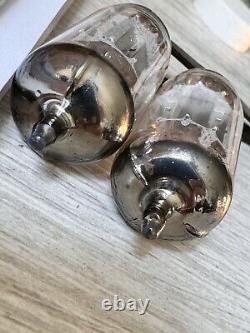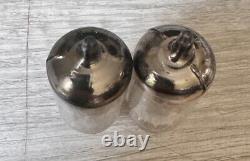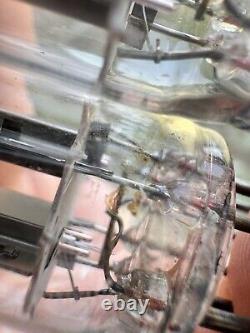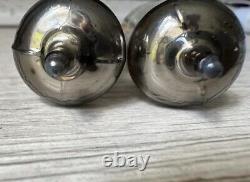
- Home
- Age
- Brand
- Antique (24)
- Birmingham (46)
- Campagnolo (28)
- Cartier (25)
- Christofle (28)
- Duchin (28)
- Estate (40)
- Fisher (25)
- Gorham (154)
- Handmade (35)
- International Silver (48)
- Native American (19)
- Reed & Barton (28)
- Sheffield (23)
- Sterling (33)
- Taxco (19)
- Tiffany & Co. (56)
- Towle (35)
- Unknown (48)
- Wallace (22)
- Other (3478)
- Composition
- Style
- Antique (52)
- Art Deco (264)
- Art Nouveau (58)
- Bangle (39)
- Baroque & Rococo (17)
- Cuff (47)
- Dangle / Drop (81)
- Elizabeth Ii (32)
- French (20)
- Georgian (33)
- Hoop (18)
- Mid-century Modern (214)
- Modern (25)
- Neoclassical (26)
- Pendant (17)
- Stud (38)
- Traditional (20)
- Victorian (113)
- Vintage (39)
- Vintage / Retro (24)
- Other (3065)
- Suitable For
- Unit Quantity
NOS platinum MATCHED PAIR ECC83 NIS PREWAR SILVER SMOOTH PLATES























THIS PAIR WAS produced at the Nis Factory in Yugoslavia on Telefunken tooling EARLIER VERSION. Smooth long plates and resembles a Telefunken, but that is where the similarity ends. Ei Yugos are excellent to use in guitar amps and audio. In audio, they have a clear and aggressive sound, somewhat like a Telefunken'on-steroids' with more personality. They have a nice detailed, balanced and very punchy clean sound and a great aggressive overdrive with extended high end.
New Old Stock in white box. Wonderful in musical instrument amps.
Ei Yugoslavia bought all of the old Telefunken stock and equipment in the 1970s, and produced these tubes, that sound very close to Telefunkens! These rare tubes have bright nickel smooth plates, they even flash orange when energized like a vintage European tube.
Have a nice detailed, balanced and very punchy clean sound and a great aggressive overdrive with extended high end. These fine tubes were produced at the Nis Factory in Yugoslavia on Telefunken tooling.The tube itself has smooth long plates and resembles a Telefunken, but that is where the similarity ends. All our tubes have been tested for.
GAS SHORTS TRANSCONDUCTANCE & EMISSIONS. These tubes have been tested - and are considered NOS ; they meet or exceed the published data set for GM.NOS tubes fall within the Gm characteristic range of an average tube, as published in the RCA RECEIVING TUBE MANUAL, which states Individual tubes, like any manufactured product, may have characteristics that range above or below the values given. Test Results are ALWAYS available upon request! I might have what you need!
Tubes will be packaged in white boxes - if the original boxes are not photographed in the listing or stated as "with original box" they are not included. 90 % of our tubes are Tv7 tested, our tv7 is Calibrated and our go to tester. The tv7 tester has been around a long time and is a trusted tester for military, who had high standards for reliable tubes that would not fail in critical conditions. Military standards were tubes needed to meet 60% (minimum value). There isn't a "specific" indicator or result or data set anywhere that universally designates a vacuum tube as "new old stock" when using a tester nor for what test result is given. The best way is to calculate the GM - and check the data sheet for each tube - a nos tube should typically measure between the average and maximum micromhos(GM). A common misconception of tube testing is that every unused tube, new or vintage, should test at 100% of the meter scale of the tester. A tube was considered acceptable/new/ passed standards if it tested between the specified minimum and maximum on a tube data sheet or the minimum value specified on the tester (tv7 is minimum is 65%). Tubes do not give the same reading across testsrs - even the same model tester will give a different reading sometimes.If you don't like the sound of a tube, so long as it is still in the same condition as arrived message me and I'll work with you. Please see my notes on noise tests below.
We have a few different testers available to ensure the quality of the tube (as some tubes can not be tested on the tv7). Tv7 testing is tedious and I spend 12-13 hours a day testing tubes and double testing tubes - if you notice a mistake(like a picture doesn't match the title) please be gracious and let me know. UNLESS PHOTOGRAPHED WITH THE ORIGINAL BOX- tube will come in repackaged white boxes- 50-90 year old cardboard packaging doesn't hold together well, not in my hands anyways. We have over the last 20 years amassed a huge collection of vintage amps/ parts / tubes and have decided to downsize that collection. Every tube has been marked for tracking and security purposes - these marks wipe off easily and without the mark no return will be accepted. Sound quality is tremendously SUBJECTIVE. This is a very marginal test, only for. This test needs sound amplification; hearing listening to noise with headphones would indicate a real disaster inside a tube (THE shorts test WOULD already BE evidence OF THIS). There is nothing wrong with performing that noise test however. That test is not going to tell you whether the tube will be silent in your SET (single ended triode) amp or in anything else. Ultimately, the best way of testing a tube for microphonics is in an actual chassis or amplifier similar to one in which it is intended to be used. Since amps have a wide variety of circuit designs and tube placement, this test is most effective in YOUR AMP or one that is almost identical. Hence, most people advertising tubes as tested for Noise or Microphonics are probably NOT testing them in any meaningful way for you."Noise" and "Microphonics" are often buzzwords for other issues. There is a small percentage of tubes that have a problem with noise but far less than most people think. In properly designed circuits objectionable "tube noise" is seldom found.
In other words, it is a rare tube that will be noisy when used in most circuits. Always check the data sheet of the tube you plan to use. PLEASE message me BEFORE you open a return.
PLEASE NOTE: Tube silkscreen (lettering on the tubes) is VERY fragile. It can be wiped off and destroyed VERY easily.

